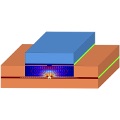This main application area takes account of an economic use of energetic resources based on mathematical modeling and optimization. With regard to future developments, sustainability and aspects of electro-mobility play a major role. Lithium-ion batteries belong to the key technologies for storing renewable energy. RG 3 and RG 7 cooperate in modeling the transport processes and their evaluation by simulations. A further focus is put on the phase-field modeling of the liquid phase crystallization of silicon in order to develop optimized thin-film solar cells in the framework of an interdisciplinary research project. Furthermore, RG 4 and RG 8 investigate aspects of uncertainty in energy management and transport via stochastic optimization or uncertainty quantification, respectively. Here, the emphasis is put on gas networks and renewable energies with uncertain parameters given, e.g., by demand, precipitation, or technical coefficients. In this context, new perspectives in modeling and analyzing equilibria in energy markets with random parameters and when coupling markets with the underlying physical or continuum mechanical proerties of the energy carrier in a power grid open up.

Optimization Problems in Energy Management
Optimization problems in energy management are concerned with the planning of production and distribution of different energy sources (power, gas), in order to cover a given customer's demand. In this context, the consideration of uncertainties (e.g., loads, meteorological parmeters, prices) in transportation networks represents a major challenge. The aim is to find cost optimal decisions which are robust at the same time with respect to uncertainties .

Thermodynamic models for electrochemical systems
The behavior of electrochemical systems is widely investigated with continuum physics models. Applications range from single crystal electrochemistry to lithium batteries and fuel cells, from biological nano-pores to electrolysis and corrosion science, and further.

Modeling and simulation of semiconductor structures
Modern semiconductor and optoelectronic devices such as semiconductor lasers or organic field-effect transistors are based on semiconductor structures, which e.g. can be given by doping profiles, heterostructures or nanostructures. For the qualitative and quantitative understanding of the properties of these devices, mathematical modeling and simulation of the most relevant and, respectively, of the limiting carrier transport processes is necessary. In the context of the Green Photonics Initiative new topics move into the focus of research, e.g. reduced energy consumption of devices, new applications in the field of renewable energies, communication and lighting.

Phase transition and hysteresis in the context of storage problems
Phase transitions and hysteresis are characteristics of energy storage problems. The aim is to formulate and analyse a thermodynamical model which discribes the storage problem.

Modeling of thin films and nano structures on substrates
Thin films play an important role in nature and many areas of technological applications. In particular on micro- and nanoscales technological processes such as dewetting or epitaxial growth are used to design surfaces with specific material properties. Apart from the need to derive mathematical decriptions, analyis and numerical simulation, that serve to accelerate the development of new technologies, it is also exciting to understand material behaviour on these small scales.
Main Areas of Application
Contact
Contributing groups
- Numerical Mathematics and Scientific Computing
- Nonlinear Optimization and Inverse Problems
- Stochastic Algorithms and Nonparametric Statistics
- Thermodynamic Modeling and Analysis of Phase Transitions
- Nonsmooth Variational Problems and Operator Equations
- Modeling, Analysis, and Scaling Limits for Bulk-Interface Processes


